WASHINGTON — With so much uncertainty around the coronavirus pandemic, some families are faced with making difficult decisions like whether or not to send their kid to college. A new study shows a gradual decline in undergraduate enrollment, especially for first-year students.
The coronavirus pandemic has been relentless on lives and livelihoods, now impacting the near-future of some students.
According to the National Student Clearinghouse Research Center, which collected data from 76% of nearly 3,600 institutions and roughly 14 million enrolled students, undergraduate enrollment slipped from 4% to nearly 4.5% just two months into the fall semester. Community colleges have seen the steepest decline, according to NSCRC. Graduate enrollment numbers are up by 2.9%.
Justin Draeger is president and CEO of the National Association of Student Financial Aid Administrators also known as NAFSAA. He said the most alarming trend reflects enrollment numbers for first-year students and funding for financial aid.
“The number of first-time students, college freshman and high school seniors who are filing a FAFSA , is down pretty significantly this year,” Draeger said. “We’re down 16%.”
This comes amid a 13% decline in the number of would-be first-time college students, a trend that’s worrisome for Draeger.
“Besides them [students] missing out on much needed financial aid and education, it’s bad for our society,” Draeger said. “These are the folks who could, with a little help, really give back to their communities , contribute to the society at large , add to the tax base.”
“I think it’s pretty hard to find anyone who disagrees that any eligible student who can succeed in college should have the opportunity to do so.”
Aaliyah Jackson is a freshman at Bowie State University, who too knows others who are in a gap year before college or decided not to go at all.
“I feel blessed that I am able to go to school, but I feel bad that other people work hard, do good on their SAT and ACT and they’re not able to go to school,” said Jackson, who opted for virtual learning when given the choice to stay home and save money.
While much of the emergency funding from the CARES Act is gone, Draeger encourages families to check with a school's financial aid office to see if additional money is available. If congress can reaching an agreement on another round of funding, he says it could really go along way.
"I hope this doesn’t turn into a longer lasting trend," said Draeger about declining enrollment numbers. "I hope we can get our arms around these students and get them the funding they need to go to college."

